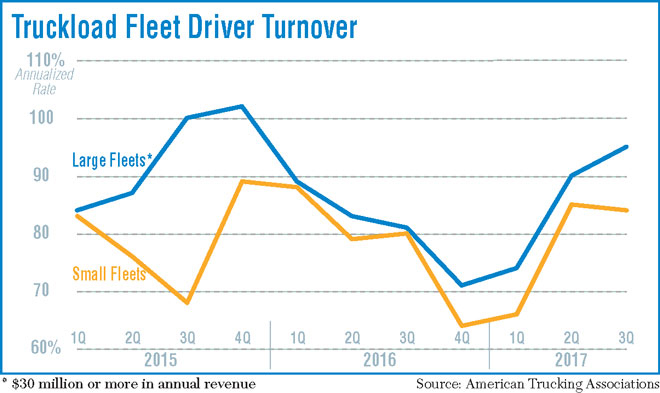Fleets Seek Drivers as Turnover Rate Hits 95%

Driver turnover at large truckload fleets rose 5% in the third quarter to a 95% annualized rate, the highest churn since the end of 2015, according to American Trucking Associations.
A number of carriers are raising pay rates and intensifying recruiting efforts as the shortage rises amid strong freight volumes.
“The turnover rate at larger fleets has steadily risen — a function of an improving economy, rising demand for freight transportation and fierce competition for drivers,” said Bob Costello, ATA chief economist.
Driver turnover rose 5 percentage points in the third quarter for large truckload fleets, while falling slightly for small TL carriers and LTL fleets. See @TRUCKINGdotORG's press release. https://t.co/fAFr9Sc1Ms
— Bob Costello (@ATAEconBob) December 7, 2017
Total truckload shipments in the third quarter set an all-time record with 974,450 shipments, a rise of nearly 12% from the same period a year ago, according to the Transportation Intermediaries Association, an industry group that tracks the freight hauling business.
Fleets are offering higher wages and other compensation for drivers but there’s still a need for more new talent, Costello said. He has calculated today’s driver shortage at more than 50,000 and predicted it could rise to 174,000 by 2024.
Not all the turnover news was negative. ATA also found that turnover at small truckload fleets — those with less than $30 million in annual revenue — fell 1 percentage point from the second quarter to an annualized rate of 84%.
The turnover rate also fell at less-than-truckload fleets to a 7% annualized rate, its lowest rate since the second quarter of 2016.

ATA launched in October a workforce development effort focusing on recruiting and retention strategies for the industry. Through its Workforce Development Subcommittee it pledged to take up job training, apprenticeships, minimum age requirements for interstate drivers and age constraints relating to insurance coverage of drivers.
Oklahoma City-based truckload carrier Freymiller Trucking has worked to recruit and retain drivers in the last three months with a 3 cents per-mile increase for both in-house drivers and the owner-operators it hires. The carrier in November also launched a guaranteed detention pay program for drivers stuck waiting to be unloaded, recruiting manager Tiffany Turner said.
The payout for the program totaled $8,000 in its first week then hit $11,000 later in November, she said. “We want to increase retention and compensate drivers for their hard work.”
Freymiller’s turnover rate has stayed around 80% in the last few quarters and its new policies will translate into a $1.7 million increase in driver compensation in 2018, said Turner. The truckload carrier operates about 500 trucks with its fleet drivers and owner-operators.
Many firms are aggressively encouraging their current drivers to recruit qualified friends and relatives to be drivers.
“Our year-to-date turnover for 2017 is right at 30%. Recruiting is tight, but I believe you can find good applicants if you look in the right spots,” said Andrew Winkler, vice president of operations with Grand Island Express, a fleet with about 130 trucks in Grand Island, Neb. “Driver referrals are our best recruiting source for experienced candidates and (we work) closely with area community colleges for entry level prospects.”
The near 100% turnover rate and driver shortage has been attributed to too few millennials replacing aging boomers who are retiring, and to prospective drivers shunning longhaul routes that take them away from home for weeks.
In response, the trucking industry has sought prospects among young people just starting their careers.
Turner said that Freymiller has had some success recruiting millennials with outreach through the social media sites Facebook, Instagram and Snapchat.
Last year the Federal Motor Carrier Safety Administration introduced a pilot program that would allow those under 21 with military driving experience to operate as professional drivers across state lines. Current federal law bans 18-21 year-olds with a commercial driver license from interstate driving.
The FMCSA program would run for three years, then the agency would compare the safety performance of a subset of the 18-21 year-olds with older drivers with similar training.
In October, Rep. Claudia Tenney (R-N.Y.) introduced a bill that takes out the military experience requirement. Instead, those between the ages of 18 and 21 with a CDL, a clean driving record and an appropriate Department of Transportation-approved training certification would be able to operate across state lines.
The Department of Labor has moved to encourage carriers to create apprenticeships for new employees to receive federal funding while they train to become drivers.




